Not all olive oil is the same. Indeed, it is necessary to learn its different types, because each type has corresponding values that influence its purity and quality.
The European Union has established a classification of olive oils according to strict parameters to safeguard the high commodity value of European olive oil and prevent it from being mixed with oils of lesser commercial value, such as pomace and seeds, whilst protecting consumers from frauds and sophistications.
The classification is established and contained in regulation no. 2568/9, amended by the Commission’s Implementing Regulation (EU) 2019/1604 to ensure the application at the Union level of the most recent international standards established by the IOC, and it determines:
The European Union has established a classification of olive oils according to strict parameters to safeguard the high commodity value of European olive oil and prevent it from being mixed with oils of lesser commercial value, such as pomace and seeds, whilst protecting consumers from frauds and sophistications.
The classification is established and contained in regulation no. 2568/9, amended by the Commission’s Implementing Regulation (EU) 2019/1604 to ensure the application at the Union level of the most recent international standards established by the IOC, and it determines:
- the physico-chemical characteristics, such as the level of acidity and the peroxide index, to establish the oxidative state of a product, the composition of fatty acids and other chemical components;
- organoleptic (sensory) characteristics, such as fruitiness and the absence of defects (taste, color, smell, touch), which depend on various factors such as the type of olive, the soil, the climatic conditions, the date of olive harvest.















